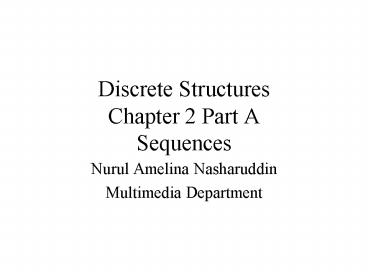Discrete Structures Chapter 2 Part A Sequences - PowerPoint PPT Presentation
1 / 13
Title:
Discrete Structures Chapter 2 Part A Sequences
Description:
Title: PowerPoint Presentation Author: Unknown User Last modified by: User Created Date: 4/8/2002 12:12:59 AM Document presentation format: On-screen Show (4:3) – PowerPoint PPT presentation
Number of Views:32
Avg rating:3.0/5.0
Title: Discrete Structures Chapter 2 Part A Sequences
1
Discrete StructuresChapter 2 Part ASequences
- Nurul Amelina Nasharuddin
- Multimedia Department
2
Sequences
- Sequence is a set of (usually infinite number of)
ordered elements a1, a2, , an, - Eg 2, 4, 6, 8,
- Each individual element ak is called a term,
where k is called an index - The example above denotes an infinite sequence
- Sequences can be computed using an explicit
formula ak k (k 1) for k gt 1 - a2 2 (2 1) 6, when k 2
- a3 3 (3 1) 12, when k 3
- a4 4 (4 1) 20, when k 4
3
Sequences
- Finding an explicit formula given initial terms
of the sequence 1, -1/4, 1/9, -1/16, 1/25,
-1/36, - Ans ak (-1)k1/ k2
- Sequence is (most often) represented in a
computer program as a single-dimensional array
a1 a2 a3 a4 a5 a6
4
Summation Operations
- Summation from k equals m to n, of ak where m ?
n - Computing summation Let a1 -2, a2 -1, a3 0
5
Summation Operations
- Changing from summation notation to expanded
form - Changing from expanded form to summation
notation
6
Summation Operations
- Evaluating a1, a2, a3, , an for small n
- n1? 1/(1.2) 1/2
- n2? 1/(1.2) 1/(2.3) 2/3
- n3? 1/(1.2) 1/(2.3) 1/(3.4) 3/4
- Recursive definition If m and n are any integers
with m lt n, then - and
7
Summation Operations
- Separating off the final term
- Adding on the final term
- Telescoping sum When writing sums in expanded
form, you sometimes see all the terms cancel
except for the first and last one.
8
Product Operations
- Product from k equals m to n of ak
- Recursive definition If m and n are any integers
with m lt n, then - and
9
Factorial Notation
- n factorial n! defined as the product of all
integers from 1 to n, - n! n ? (n 1) ? ? 3 ? 2 ? 1
- Zero factorial 0! 1
- Simplify the factorials
10
Properties
- If am, am1, am2, and bm, bm1, bm2, are
sequence of real numbers and c is any real
number, then the following equations hold for any
integer n ? m
11
Change of Variable
- Observe that
- Transform a sum by changing variable
- Calculate new lower and upper limits
- When k 0, j k 1 0 1 1.
- When k 6, j k 1 6 1 7.
- The new sum goes from j 1 to 7
12
Change of Variable
- Calculate new general term
- Since j k 1, then k j 1.
- Hence
- Finally put the steps together
13
Exercise
- Compute
- Transform by making the change of variable
j i 1 - Send in the answers on the next class!

